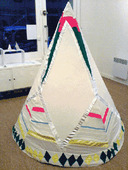|
|
|
|
Matthew
Lutz-Kinoy
YUKIKO
KAWASE
8 rue Adolphe Focillon
November 08–January
07 |
|
|
Matthew Lutz-Kinoy's "Un cône nommé
désir" (A Cone Named Desire) is an oblique echo of Anthony
McCall's well known luminous cones, a recent iteration of
which was just on view at Martine Aboucaya. If one places
these exhibitions within the same frame of reference, one can
see that the artists take very different approaches. McCall
makes the cone-as-geometric-figure tangible, presenting it
optically. Lutz-Kinoy, on the other hand, presents the cone as
an object (from the Greek kônos, pine cone); in the
gallery it serves as a tepee of sorts, constructed from fabric
stretched over a cardboard frame and surrounded by smaller,
cardboard-only cones. This object occupies the central
position in the exhibition; on its left, video documentation
of a performance shows the artist, dressed in a skin-tight
white unitard festooned with green diamond shapes (mirroring
those on the sculpture nearby), dancing to old R&B hits.
This incantatory movement enhances the enigmatic character of
the sculpture, turning the artist into a supplicant engaged in
a ritualized affirmation of this strange object.
—Marie Bonnet
TALK
BACK (0 messages)  E-MAIL E-MAIL  PRINT PRINT |
|
 |
|
Cone,
2005. | |
| |
|
Laurent
Montaron
LA
GALERIE, CENTRE D'ART CONTEMPORAIN
1 rue Jean-Jaurès,
Noisy-le-Sec
November 19–January 21 |
|
|
It has been several years since the young
artist Laurent Montaron's last show in Paris, and here he
demonstrates, in a very well-articulated exhibition, that it
can be wise to stand aloof. Welcomed by Melancholia,
2004, a mute sculpture made from loops of magnetic tape
extracted from a "space echo"—a sound machine from the
‘70s—the viewer is everywhere confronted by haunting and
enigmatic devices. Nearby, a rumbling soundtrack draws one
toward a 35mm film projection (Readings, 2005) that
portrays a gigantic, outdated engine room undergoing a slow
transformation. Strange subtitles, which seem like prophecies,
comment on the metamorphosis; eventually this machine is
revealed as an observatory telescope. Elsewhere, despite its
apparent quietness, the still-image projection Spit,
2004, plunges the viewer into hypnotic contemplation. The
life-size image of a woman sitting precariously on a
skyscraper balcony and spitting into the void appears to be
pulsating. The effect is produced by no more than the rotating
blades of a fan in front of the projector, but even if the
trick is revealed, one's gaze is caught by the image's
tangibility, a feeling not unlike encountering a Jeff Wall
photograph for the first time.
—Charlotte Laubard
TALK
BACK (0 messages)  E-MAIL E-MAIL  PRINT PRINT |
|
.jpg) |
|
Spit,
2004. | |
| |
|
Philippe Bazin
GALERIE ANNE BARRAULT
22, rue Saint
Claude
October 29–December 23 |
|
|
As "citizens of modernity," Susan Sontag
claimed, we are "schooled to be cynical about the possibility
of sincerity." Paris-based Philippe Bazin's faith in the
ethical implications of portrait photography forces us to
entertain that very possibility. For two decades, Bazin has
photographed anonymous faces: newborns, adolescents, the
elderly, workers, militants, prisoners, and the insane. Bazin
always shoots his subjects in relationship to institutional
contexts—the hospital, the prison, the school—that are not
evident in the final works. His current show, which includes
recent photo and video work focusing on landscapes, brings
this idea of absent context forcefully into play. Five
black-and-white portraits of men who have done time
(Détenus, 1996) are hung in a row facing Loos,
2005, a video of the grounds surrounding the prison. Between
them, monitors, arranged in a straight line, display fixed
perspectives of the areas in and around other French prison
towns like Fresnes and Villepinte. They are not, but could be,
views from prison windows; the stillness of the camera and the
unchanging banality of the scenes suffocate. In the back of
the gallery a large color image of a Scottish seascape titled
Uist Island, 2002, provides respite, until you realize
that as you move closer to any horizon, it moves further
away.
—Vivian Rehberg
TALK
BACK (0 messages)  E-MAIL E-MAIL  PRINT PRINT |
|
.jpg) |
|
Uist Island,
2002. | |
| |
| |
|
| |































